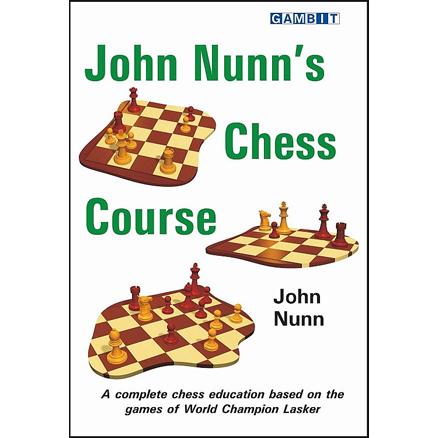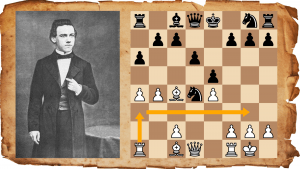
Review: John Nunn's Chess Course
There is much debate these days about whether Magnus Carlsen has already surpassed Garry Kasparov as the best player of all time - have these people forgotten that Carlsen has only been World Champion for less than a year now? Kasparov reigned for fifteen years while Lasker, on the other hand, was World Champion for twenty seven years. The Norwegian youngster still has a long way to go.
John Nunn has recently published a very interesting chess improvement book based on the games of Emanuel Lasker (1868-1941): John Nunn's Chess Course, published by Gambit. The reasons should be obvious. In Nunn's own words:
"His chess credentials are impeccable, as he was World Champion for 27 years, longer than any other person. Moreover, he had what is often termed a 'universal' style, in that he could handle all types of position well, and therefore a study of his games would benefit all aspects of the reader's style. His style tended towards straightforward plans, which he executed precisely. Such clear-cut play is especially instructive, because it's possible to understand what he was trying to do and transfer the learning to one's own games. I certainly gained a great deal from looking at his games in detail, and felt that my own understanding of chess had become broader as a result."
Nunn's book, however, is not a biography of Lasker, and the focus is very much on Lasker's games and their instructive qualities. In fact, "the Doctor" has clear ambitions to "cover the most important chess themes", with a "strong emphasis on thought-processes and decision-making". Nor is it the kind of book that only shows fragments where the hero plays exclamation mark moves and mercilessly crushes his inferior opponents. The following fragment is from the chapter 'Piece Activity':
"12.d4? Lasker had to decide between play in the centre and play on the kingside and he makes the wrong choice. Just at the moment, White's position is a little clumsy since his knight is pinned and Black's pieces are relatively active, so it's risky to open the centre immediately. Instead 12.g4 Bg6 13.h4 f6 14.Rdg1 was correct, with a definite advantage for White. In fact, White is playing a minority attack, which more often occurs on the queenside and is familiar from openings such as the Exchange Variation of the Queen's Gambit Declined (...). However, the minority attack is not restricted to one particular opening and can occur in other situations. The idea is to play g5 and gxf6, leaving Black with either a backward f-pawn or an isolated e-pawn. The minority attack is particularly effective in this position because of the clumsy positioning of Black's minor pieces, which allow White's pawns to advance with gain of tempo.
12...exd4?! This undoubles White's e-pawns and exchanges Black's last outpost in the centre. The solid 12...f6 would have been better, since Black will have to play this sooner or later in any case. Black gains flexibility by avoiding an immediate ...exd4, since he can always exchange on d4 later, but White also has to take into account the possibility that Black will not exchange. Swapping straight away is doubtful not only from a pure chess point of view, but also because it makes White's life simpler. However, the strongest move of all is 12...f5!, exploiting the momentary instability of White's position. (...)"
This little fragment is vintage Nunn. He is always critical and looking for improvements on both sides. He uses examples from very different situations to explain characteristics of a position. And he always gives alternatives and elaborates on their respective merits. Most of all, he is objective and tries to treat any game of chess as a neutral battle, without prejudice.
This becomes particularly clear in the chapter 'Misunderstood Genius' in which Nunn discusses Lasker's reputation and how chess commentators have dealt with his games. It appears to me that much of what he says can also be said of Magnus Carlsen, and serves as a good antidote to those who, despite his successes, still criticize the current World Champion's play.
"The general perception of Lasker is that he was an extremely lucky player and regularly swindled his opponents. It's true that he was skilfull at turning round inferior positions, but these reversals owed less to swindling than to his general chess skill and in particular his ability to create deceptive situations on the chessboard."
Nunn then goes on to discuss well-estabilished narratives of Lasker's games, and how annotators "just repeat the same story again and again":
"In the case of Lasker's games it was often very wrong. (...) One problem with faulty assessments is not that they are misleading or just plain wrong, but they also obscure the instructive qualities of the games. For example, annotators, believing Black to be better in a particular position, often come up with all sorts of ingenious and superficially convincing explanations as to why this should be so. However, if the position is in fact equal, then these explanations cannot possibly be correct, and the principles which are supposed to be illustrated by the example are in fact irrelevant to the given position."
Nunn does convincingly (as far as I can see) demonstrate faults in earlier books on Lasker by Crouch, Soloviov and Soltis, but I still think he is sometimes being a little too harsh to them, especially to Andrew Soltis, whose 2005 book, after all, is called Why Lasker Matters. It is thus a direct predecessor of Nunn's own work at least in spirit. The impression Nunn tries to give here and there is that he's somehow the first to truly recognize Lasker's 'misunderstood genius' - this is a bit too extreme in my opinion.
Having said that, when Nunn writes that for many of Lasker's games he has been "able to shed a new and instructive light on them", I can't but agree with him. One of the best examples of this is his treatment of the famous game Lasker-Lasker (Emanuel vs. Edward, that is), New York 1924.
Years ago, I analysed this game myself at some length together with members of my former chess club MEMO in Amsterdam, and I was quite curious to see what Nunn had to say about it. Nunn points out that "the following famous ending has been analysed many times, but much of this analysis is riddled with errors and so the most instructive points have been obscured. The first key point is the use of the king to halt the enemy passed pawns, while the final phase shows Emanuel Lasker finding a remarkable fortress draw to save the game."
It is indeed true that even the best analysts have erred in this notoriously difficult endgame - notably Garry Kasparov who, in his My Great Predecessors I, failed to grasp most basic defensive ideas and has been harshly criticized for this by Mark Dvoretsky among others. Nunn, to his credit, doesn't rake up this old controversy (he doesn't even mention Kasparov's name) but improves on Dvoretsky too as he goes along. I'll leave it to the reader to look into the details of this fascinating ending.
In general, Lasker's endgame skills are regarded highly by Nunn, especially where Lasker "makes something from nothing". Again, the similarities with Carlsen's play should be obvious:
"It's easy to imagine any of the positions in this chapter being agreed drawn, and nobody would think anything odd about such a decision, yet they were all won by Lasker. How did he achieve this? (...)
- There's no point in continuing unless you have the appetite to play on and the desire to win the game no matter how long it takes.
- Wear your opponent down by trying one plan after another. This is effective even if the threats involved are very minor, as your opponent won't want to make any concession.
- You have to be alert to pounce on any inaccuracies that your opponent makes."
In the same period I read and reviewed John Nunn's Chess Course, I was also reading The Curiosity, a fascinating novel by Stephen P.Kiernan about a man born in 1868 who, after having been frozen in an iceberg for over a century, awakes in modern-day Boston. Emanuel Lasker, too, was born in 1868, and I couldn't help wondering what he would think about the world, and the world of chess especially, if he were still alive. He would surely be stunned by the number of grandmasters and the average level of play, but wouldn't he also still recognize many elements and styles, including his own influence on the current champ?
Even though he's been dead for over seventy years, not all tangible links to the second world champion have been lost yet. The well-known Dutch centenarian and chess player Johan van Hulst, who turned 103 years old this February, likes to tell the story of how he met Lasker and had a polite conversation with him, back in 1935.
During the Alekhine-Euwe match in Amsterdam, Van Hulst asked Lasker what he thought of the position on the board. The great player replied that there were definitely practical chances for both players. A better summary of Lasker's pragmatic and psychological approach, as described wonderfully in John Nunn's Chess Course, is hardly thinkable.






